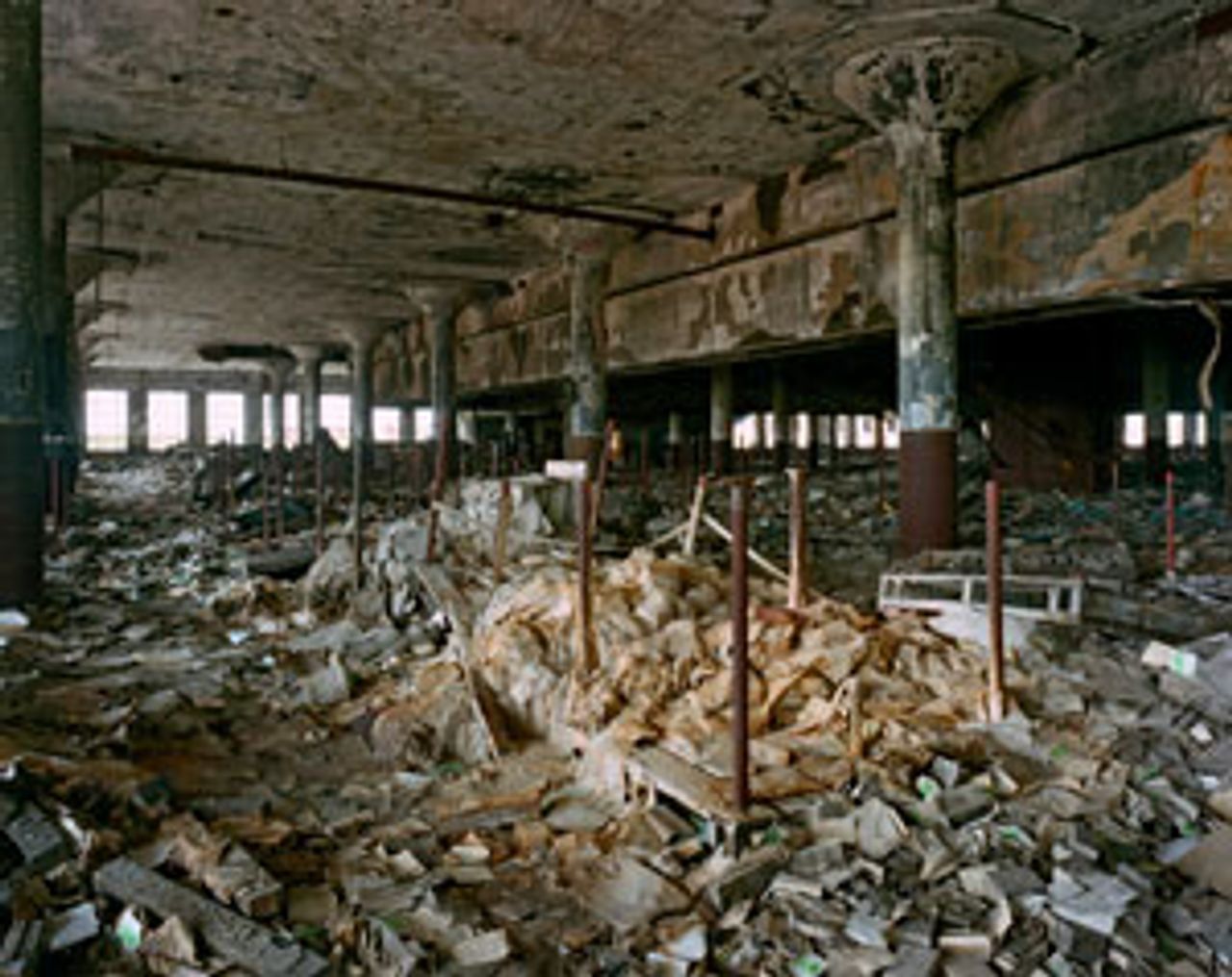For almost a century, Detroit was synonymous with automobile manufacturing, mass production and the dominance of American industry. In the immediate aftermath of the Second World War, for example, one out of every two automobiles produced anywhere was assembled in the Detroit area. It was a bustling metropolis at the manufacturing center of the world’s most powerful nation. By contrast, today’s cityscape is rife with images of decay.
Andrew Moore’s photographs in his Detroit Disassembled give expression to that historical contradiction and tragedy; and they do so with a seductive beauty that is hard to resist. In a recent conversation, Moore called Detroit a metaphor for America. Once the fastest-growing city in the world, it has unraveled at a virtually unprecedented pace.
Moore’s series of 75 prints reveals an almost indiscriminate destruction, beginning with the city’s industrial mainspring and running through every aspect of life in what was the nation’s fourth-largest urban center. Theaters, libraries, dance halls, neighborhoods and schools have been reduced to crumbling ruins, overtaken by wildflowers, vines and burgeoning forest. His images are candid, direct, searching.
Moore credits the arrangement and flow of the pictures to his editor, Alice Rose George, a long-time master of the craft. Pivotal locations, like Detroit Central Station, for example, or the school book depository, the Ford Rouge plant and the Packard plant, appear and recede, only to reappear later with an effect that emphasizes the universality and lawful character of what has taken place. Instead of a collection of isolated vignettes, the lens brings into focus one complex and multi-sided process of desolation overtaking society, as if a sinister force of nature were at work.
The return of wild plants and animals in place of factories, schools and neighborhoods in modern America is significant. The word “culture” takes its meaning from that which has been cultivated, as distinct from “virgin forest and virgin soil,” and worked up by humanity—ultimately, class-divided humanity—for the satisfaction of its needs.
From sticks and stone implements through electronically-integrated, global processes, the tools of production have been expanded to increase the productivity of labor. These tools form the material foundations of human culture as a whole. Hence, the implications of the sudden loss of such massive instruments as Detroit’s factories make the current study all the more riveting.
Detroit has suffered an economic, social and cultural earthquake. The corporate interests that pumped profit from the factories have shut them. Huge cranes, turbines, furnaces and drive shafts are motionless. At the Ford Rouge factory, the rolling hall gapes like an empty canyon glowing in the sunset. The concrete frames that once supported miles of assembly lines and tens of thousands of workers, collapse and crumble. Old sockets and screw drivers are for sale from a station wagon.
A recent editorial in the Detroit Free Press, entitled “Right-Size the right way,” attempts to portray a proposal by Detroit’s millionaire mayor, David Bing, for the violent dislocation of tens of thousands of residents as an act of philanthropy and progressive city planning that will benefit all concerned. The real thrust, however, will be slicing large sums from a city budget that has already been savaged. “Right-sizing the city is essential,” says the paper, “to fixing the city’s structural budget problem.”
Directly or indirectly, Moore’s images condemn the current set-up and challenge the reader to come to grips with the historical forces which have been rending the city into smaller and smaller pieces—disassembling it, as it were.
Near the end of the work, on pages 104 and 105, the skeleton of a cat that died peacefully on a library cushion, having starved to death, faces a narrow alley full of ice. The alley, too, is a tomb in its own way. A man stepped away from his wheel barrow in the midst of moving a pile of bricks. Both valuable and ordinary objects have been left, as if the population had been swept away by a sudden catastrophe. Frame after frame reveal other aspects of destruction until the book ends in a field of puddles, Queen Ann’s Lace and wild bushes.
In reality, almost a million people still inhabit the city, struggling to survive and learn in the midst of its collapse.
During the second decade of the 20th century, Ford Motor Company ran ads in European newspapers from its headquarters in Highland Park, Michigan, enticing workers with offers of better wages than could be made anywhere else. America was taking over. In the picture on page 31, a carpet of tiny iridescent plants consumes the woven rug in a walnut-paneled office of that empty, historic building in front of the Model T plant on Woodward Avenue.
The young reader who wonders what the factories were like in the heady days has only to travel down Woodward Avenue and see the Diego Rivera frescos at the Detroit Institute of Art (DIA). Rivera studied Ford’s Rouge plant in the early 1930s and filled the central space at the DIA with its tumult and power.
Some auto workers still receive livable wages. But the recent bankruptcy forced on employees at General Motors and Chrysler by the Obama administration slashed benefits for new hires and cut their pay by 50 percent. The aim is to create poverty-wage conditions once again that will be attractive to investors. In a move that is typical of the process, Ford sold to a Russian firm its Rouge steel mill, pictured behind blocks of crushed cars on page 34.
When the factories were booming, the city had fine theaters, dance halls and department stores. Many workers enjoyed manicured lawns on attractive streets with decent schools, libraries, parks and swimming pools. Today, the empty shell of a theater serves as a parking garage where paint and plaster peel from the arches. At Michigan Central Station, the grand concourse, Corinthian columns and majestic vaults have been abandoned to drifting snow. A house on Walden Street is smothered by foliage. Only a few shingles and a rake board can be seen.
Andrew Moore was born in 1957. By the time he left Princeton University, the labor movement was entering into a period of protracted decline. In 1979, Paul Volcker, President Jimmy Carter’s choice to head the Federal Reserve (US central bank), sharply raised interest rates to provoke recession, destroy jobs and drive down wages. Detroit’s Dodge Main plant closed that year, part of the first round of concessions and closures.
Since that time the onslaught against the working class in Detroit has never stopped. Over the past several decades, the UAW, built by workers in bloody struggle, has become an instrument of the corporations for suppressing auto workers and devastating their living standards and working conditions.
It is perhaps no wonder then, that the historical movement of the working class failed to place its stamp on the photographer’s artistic sensibility. The tradition of the sit-down strikes and the Battle of the Overpass (1937) has been suppressed for most of his professional life. Unions, churches and politicians have thus far escaped the photographer’s attention. To focus on their role in stifling the struggles of workers would go a long way toward explaining how the corporations succeeded in wiping out large portions of the city, without facing organized resistance.
 Moore’s shots of city residents are of dispossessed descendants wandering in the ruins of their ancestors’ homes. Delvin, Lance and Devante stare aimlessly from the front of an abandoned house on the East Side (page 89). The weeds behind them are taller than they are. A group of four school children pose with an adult in the middle of a street on an overgrown block in Highland Park (page 107). Only two houses are standing. Uncut grass has consumed the sidewalks.
Moore’s shots of city residents are of dispossessed descendants wandering in the ruins of their ancestors’ homes. Delvin, Lance and Devante stare aimlessly from the front of an abandoned house on the East Side (page 89). The weeds behind them are taller than they are. A group of four school children pose with an adult in the middle of a street on an overgrown block in Highland Park (page 107). Only two houses are standing. Uncut grass has consumed the sidewalks.
Still, the book contains a searing critique of contemporary life. In so doing, it anticipates the reappearance of the working class onto the stage of history, in Detroit too, where it will once again take up its role of transforming global society.

